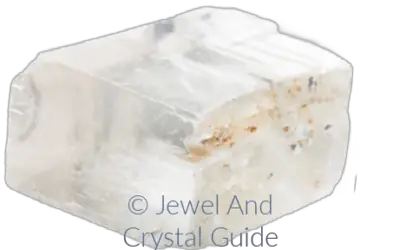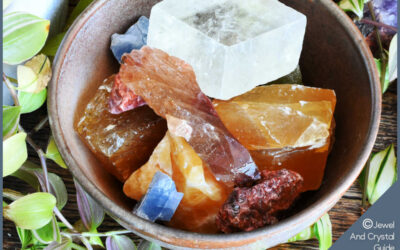Aventurine and jade can look a lot alike, especially when aventurine is dark green. Even though they can look the same, they definitely aren’t the same:
Aventurine is quartz crystal that’s most often green and has a shimmer. Jade is one of two different materials: nephrite and jadeite. Jade is usually green and comes from rocks. Jade and aventurine get mixed up most often when they’re tumbled and polished smooth, and dark green.
Let’s explore what makes aventurine different from jade, and how you can test a piece to tell which one it is.
In this blog post, you’ll discover:
- The differences between aventurine and jade
- A table of differences between jade and aventurine
- How to test for aventurine and jade, to get an idea of what a stone is
The differences between aventurine and jade
Here’s a list of differences between aventurine and jade…
Aventurine is quartz crystal, jade is two different minerals
Aventurine is quartz crystal made up of silicon and oxygen. It has small inclusions of other minerals, usually fuchsite or hematite in it. These inclusions give aventurine a shimmering effect called aventurescence.
Fuchsite is a green-colored mica that contains chromium and adds to the green color of aventurine. Hematite, an iron oxide, creates a reddish-brown or metallic shimmer in aventurine. The amount and distribution of these inclusions determine the intensity of the aventurescence and the overall appearance of the gemstone.
Jade is a name for two different minerals: nephrite jade and jadeite jade.
– Nephrite jade is a variety of actinolite. Actinolite is a green-colored mineral that’s usually found in metamorphic rocks and has a fibrous or column-like crystal structure. It is primarily made up of calcium, magnesium, iron, silicon, and hydrogen. Nephrite jade is usually green, ranging from light to dark, but can also be found in other colors like white, gray, brown, and black.
– Jadeite jade is made of a pyroxene mineral called jadeite. Pyroxenes are silicates that help form rocks and usually contain elements like silicon, oxygen, aluminum, iron, magnesium, and calcium. Jadeite jade has a wider range of colors than nephrite jade, including vibrant greens, as well as other colors like white, lavender, yellow, and even red.

Aventurine is usually opaque, jade can be more transparent
Translucent stones allow some light to pass through but are not completely transparent, giving them a somewhat hazy appearance. Opaque stones do not allow any light to pass through them, giving them a solid and non-translucent appearance.
Both aventurine and jade can have different degrees of transparency, with aventurine tending to be more translucent to opaque and jade having the potential for higher transparency (especially top-quality jadeite jade).
Aventurine is typically translucent to opaque, meaning it does not allow much light to pass through it, but the degree of transparency depends on the piece.
Nephrite jade is typically opaque to translucent because its dense and fibrous structure often limits the amount of light passing through the stone. Some jadeite jade has excellent transparency, especially in higher-quality specimens.
Aventurine and jade come in green and different colors

Aventurine is most commonly green, ranging from light to dark green. But it also comes in other colors such as peach, yellow, orange, brown, blue, and gray.
When aventurine is dark green, it looks a lot like real jade!
Jade is most commonly associated with shades of green, from pale and translucent to intense and vibrant depending on the type and quality of the jade. But jade can occur in other colors such as white, lavender, yellow, black, and various shades of gray and brown. These colors can occur naturally or may be enhanced through treatments, especially with jadeite jade.
Aventurine and jade come from different countries/areas
Aventurine is found in various locations around the world. Some notable sources of aventurine are:
– India is a significant producer of aventurine. It is known for its green aventurine, often referred to as “Indian Jade.”
– Brazil is another prominent source of aventurine. It is known for its variety of colors, including green, blue, orange, and red aventurine.
– Russia is known for its green aventurine, particularly from the Ural Mountains region.
– Chile is known for its green and blue-green aventurine, often called “Chilean Jade.”
– South Africa is a notable producer of aventurine, especially the green variety.
Here are some significant sources of jade:
– Myanmar (Burma) has long been renowned for its jadeite jade, considered one of the most precious and valuable types of jade.
– Various regions in China have been known for their jade deposits, including Xinjiang, Hetian, and Liangzhu. Chinese jade is traditionally associated with nephrite jade, although jadeite jade is also highly valued.
– Guatemala is known for its jadeite jade, particularly the prized “imperial jade” with its intense green color. The region of Alta Verapaz in Guatemala is a significant source of jadeite jade.
– British Columbia in Canada is known for its nephrite jade deposits. The area of Jade City, in particular, has become renowned for its high-quality nephrite jade.
Other countries such as Russia, Kazakhstan, New Zealand, and the United States (Alaska, California) also have deposits of jade, both nephrite and jadeite.
Aventurine is for emotions and jade is for luck and wisdom
Jade has a long and rich cultural significance, particularly in East Asian and Mesoamerican civilizations. Some cultural beliefs and symbolism associated with jade are:
– Wisdom and Virtue: Jade is considered a symbol of wisdom, virtue, and purity. It is believed to embody qualities such as integrity, compassion, and justice.
– Protection and Good Luck: Jade is often believed to provide protection against negative energies and bring good luck and fortune to its wearer. It is considered a talisman for warding off harm and attracting positive energy.
– Spiritual and Healing Properties: Jade is associated with spiritual and healing properties. It is believed to promote balance, harmony, and emotional well-being. Jade is also thought to have a calming effect on the mind and help in meditation and spiritual practices.
– Cultural Heritage and Royalty: Jade is associated with imperial power, representing wealth, status, and royalty.
Aventurine does not have the same longstanding cultural significance as jade, but it is still appreciated and valued for symbolizing:
– Luck and Prosperity: Aventurine is often considered a stone of luck and good fortune. It is believed to bring opportunities, abundance, and positive outcomes in various endeavors.
– Emotional Healing: Aventurine is associated with emotional healing, promoting harmony, and soothing feelings of stress and anxiety. It is believed to help calm the mind and bring inner peace.
– Vitality and Growth: Aventurine is associated with vitality, growth, and renewal. It is believed to enhance one’s sense of well-being, motivation, and personal development.
Jade is more valuable than aventurine
As a general rule, jade, especially jadeite jade, is more valuable than aventurine because of four reasons:
- Jade is a precious gemstone with significant value, aventurine is a quartz crystal.
- High-quality jade, especially fine jadeite jade, is relatively rare and scarce compared to aventurine. The availability of top-grade jade is limited, particularly with very desirable colors and translucency levels. This scarcity contributes to its higher price as demand is often greater than supply.
- Jade has an enduring cultural significance in various cultures, particularly in East Asia. The strong cultural demand for jade, especially for high-quality jadeite jade, drives up its price in the market.
- Jade, especially top-grade jadeite jade, has exceptional beauty, with vibrant colors, high translucency, and fine texture. The intensity and even distribution of its green color, along with its excellent clarity, contribute to its value.
The following table compares the average price between aventurine and jade, based on current market values:
| Low Grade | Medium Grade | High Grade | |
| Aventurine | $0.10 – $1 per gram | $1 – $5 per gram | $5 – $20+ per gram |
| Jade | $5 – $25 per gram | $25 – $250 per gram | $250 – $5,000+ per gram |
© Jewel And Crystal Guide
Table of differences between aventurine and jade
The table below is a quick guide to all the differences between aventurine and jade that I explained in detail above:
| Property | Aventurine | Jade |
| Composition | Quartz crystal | Nephrite jade: actinolite Jadeite jade: jadeite |
| Transparency | Translucent to opaque | Higher transparency |
| Color | Green, peach, yellow, orange, brown, blue, gray | Green, white, lavender, yellow, black, and various shades of gray and brown |
| Origin | India, Brazil, Russia, Chile, South Africa | Myanmar (Burma), China, Guatemala, Canada, Russia, Kazakhstan, New Zealand, USA (Alaska, California) |
| Value | Less valuable | More valuable |
© Jewel And Crystal Guide
How to tell if a piece if aventurine or jade
While professional gemological testing is the most accurate way to determine whether a piece is aventurine or jade, here are a few simple tests you can do to gather some initial information:
1. Visual Inspection
Examine the color and appearance of the stone.
Aventurine is known for its sparkly inclusions and comes in various colors, while jade typically has a smooth and waxy appearance with shades of green or other colors depending on the type.
Look for any distinct patterns or markings that are characteristic of jade, such as the sought-after “imperial green” color in jadeite jade.
2. Hardness Test
Use a common household item like a steel knife or a glass plate to test the hardness of the stone.
Aventurine, with a hardness of 6 to 7 on the Mohs scale (a scale that measures how hard minerals are), can scratch glass.
Jade, with a hardness of around 6 to 7, should be able to scratch the steel knife or leave a mark on glass.
3. Density Test
Compare the weight of the stone in question to a known sample of aventurine or jade of a similar size.
Jade is generally denser and heavier than aventurine, but this test may not be conclusive as other factors like impurities can affect density.
4. Translucency Test
Hold the stone up to a light source and look at how much light passes through it.
Aventurine is typically translucent to opaque, while jade can range from translucent to opaque, with high-quality jadeite jade often displaying better transparency.











